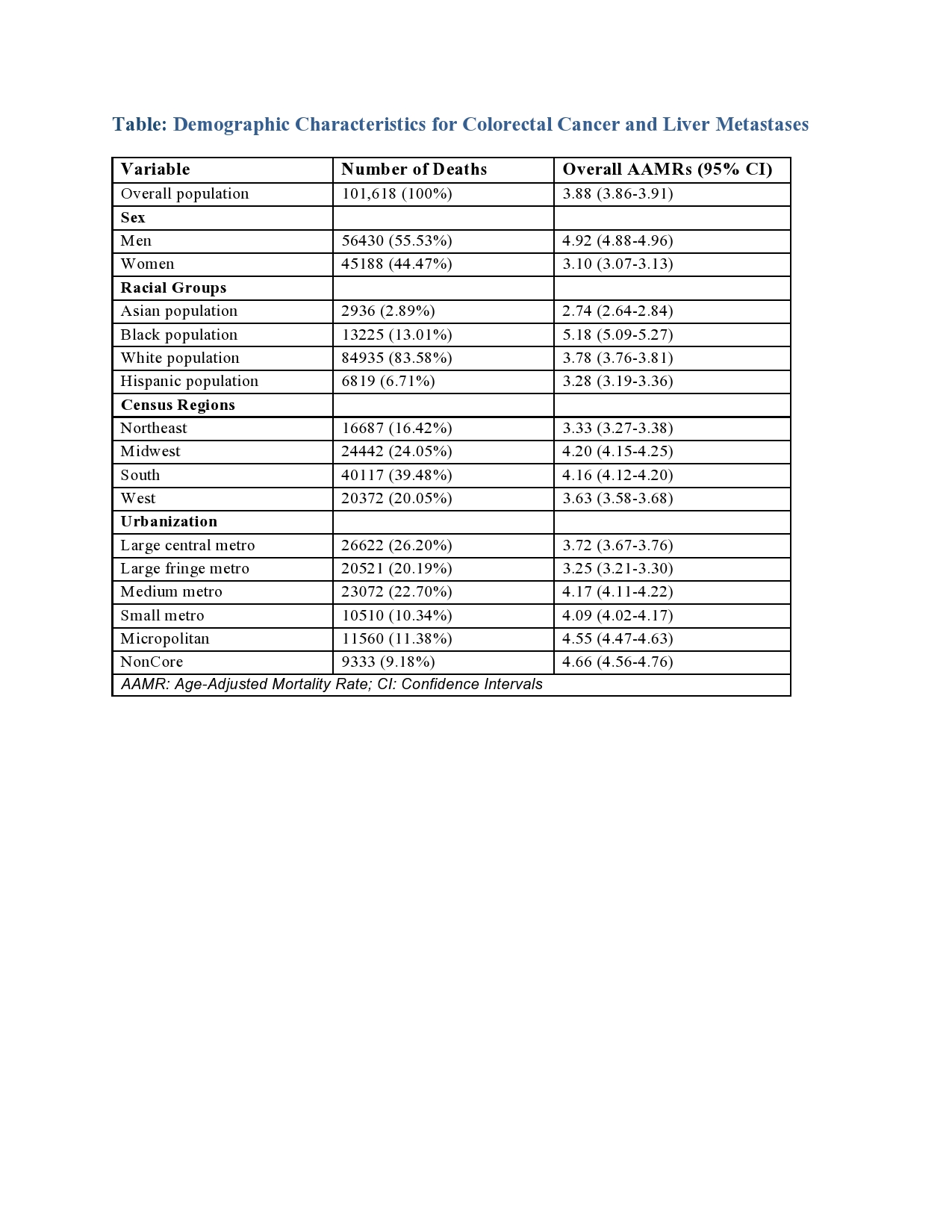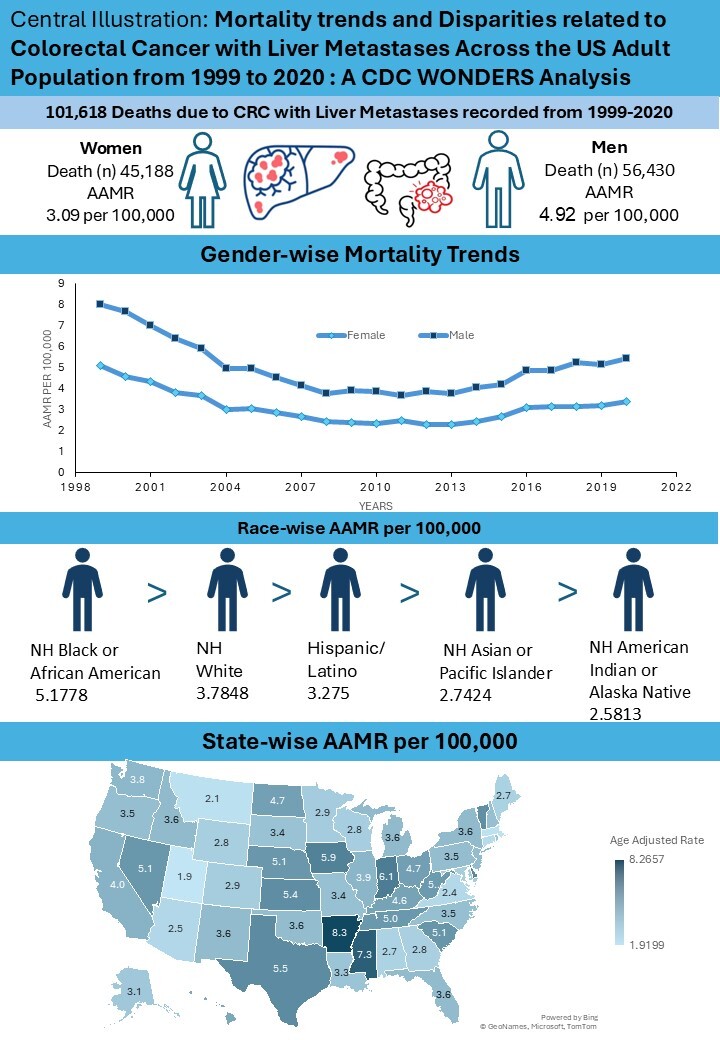Tuesday Poster Session
Category: Colon
P4550 - Mortality Trends and Disparities Related to Colorectal Cancer With Liver Metastases Across the US Adult Population from 1999 to 2020: A CDC WONDER Analysis
- AK
Anum Khakwani, MD (she/her/hers)
Charleston Area Medical Center
Charleston, WV
Presenting Author(s)
1Nishtar Medical University, Multan, Punjab, Pakistan; 2Charleston Area Medical Center, Charleston, WV; 3King Edward Medical University, Lahore, Punjab, Pakistan; 4Mercy Clinic East Communities, Festus, MO
Introduction: Colorectal cancer (CRC) with liver metastases affects approximately 50% of patients, significantly worsening survival. This study analyzes mortality trends from 1999 to 2020 to identify inequities and inform targeted interventions.
Methods:
Using CDC WONDER death certificate data (1999–2020) for adults aged 45 years and older with CRC (ICD-10: C18–C21) and secondary liver metastases (C78.7), we calculated age-adjusted mortality rates (AAMRs) per 100,000 population, stratified by sex, race/ethnicity (e.g., Black, White), census region (Northeast, Midwest, South, West), urban-rural classification (e.g., micropolitan, large central metro), state, and place of death. Annual percent changes (APCs) were estimated via Joinpoint regression, with 95% confidence intervals (CIs); statistical significance was set at p< 0.05.
Results:
From 1999 to 2020, 101,618 deaths were attributed to CRC with liver metastases, with 48,470 occurring at the decedent’s home. AAMRs declined from 1999–2010, notably for men (1999–2008: APC -8.16 [-9.07, -7.24]), Black individuals (1999–2009: -7.99 [-9.55, -6.41]), the Northeast (1999–2010: -9.08 [-9.70, -8.46]), and medium metro areas (1999–2004: -9.17 [-11.76, -6.50]). Increases occurred post-2013, particularly for men (2013–2020: 5.39 [3.97, 6.83]), White individuals (2013–2016: 9.48 [1.03, 18.63]), the Midwest (2013–2020: 7.35 [5.52, 9.21]), and large fringe metro areas (2014–2017: 12.71 [4.42, 21.66]). In 2020, AAMRs were higher for men (5.46; 95% CI, 5.27–5.64) than women (3.38; 95% CI, 3.25–3.51); Black individuals (4.82; 95% CI, 4.47–5.17) than White (4.10; 95% CI, 3.95–4.25); the Midwest (4.80; 95% CI, 4.55–5.05) than the Northeast (2.60; 95% CI, 2.41–2.80); and micropolitan areas (5.80; 95% CI, 5.38–6.22) than large central metro areas (3.84; 95% CI, 3.65–4.04). Arkansas had the highest state AAMR (8.27; 95% CI, 7.91–8.62).
Discussion:
CRC with liver metastases mortality declined until 2010 but increased through 2020, with persistent disparities by sex, race, region, and urbanization. Higher AAMRs among men, Black individuals, Midwest residents, and micropolitan populations highlight the need for enhanced screening and treatment access. Future research should investigate drivers of recent mortality increases to address these inequities effectively.
Figure: Demographic Characteristics for Colorectal Cancer and Liver Metastases
Figure: Central Illustration: Mortality trends and Disparities Related to Colorectal Cancer with Liver Metastases Across the U.S. Adult Population from 1999 to 2020: A CDC WONDERS Analysis
Disclosures:
Huzaifa Noor indicated no relevant financial relationships.
Aqsa Komel indicated no relevant financial relationships.
Azka Aisha indicated no relevant financial relationships.
Muhammad Siddiqui indicated no relevant financial relationships.
Muhammad Hassan indicated no relevant financial relationships.
Roohi Bano indicated no relevant financial relationships.
Amna Ramzan indicated no relevant financial relationships.
Anum Khakwani indicated no relevant financial relationships.
Fatima Ashfaq indicated no relevant financial relationships.
Muneeb Khawar indicated no relevant financial relationships.
Zubair Khan indicated no relevant financial relationships.
Huzaifa Noor, MBBS1, Aqsa Komel, MBBS1, Azka Aisha, MBBS1, Muhammad Siddiqui, MBBS1, Muhammad Hassan, MBBS1, Roohi Bano, MBBS1, Amna Ramzan, MBBS1, Anum Khakwani, MD2, Fatima Ashfaq, MBBS1, Muneeb Khawar, MBBS3, Zubair Khan, MD4. P4550 - Mortality Trends and Disparities Related to Colorectal Cancer With Liver Metastases Across the US Adult Population from 1999 to 2020: A CDC WONDER Analysis, ACG 2025 Annual Scientific Meeting Abstracts. Phoenix, AZ: American College of Gastroenterology.
